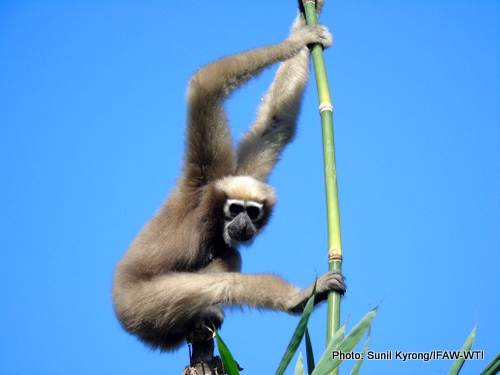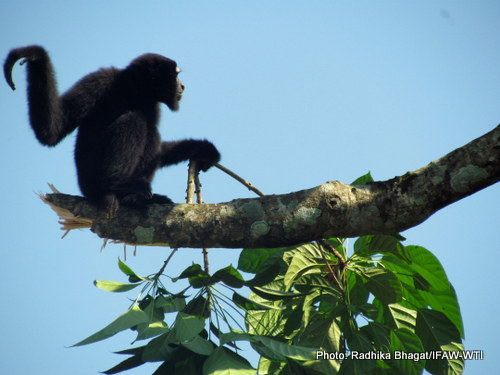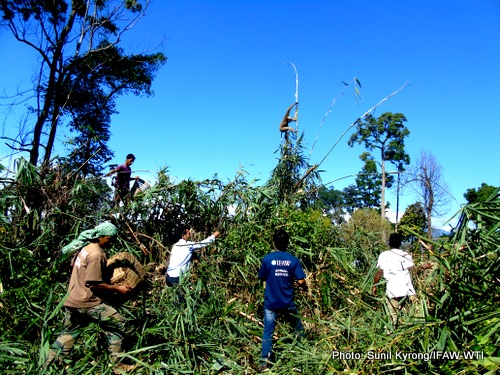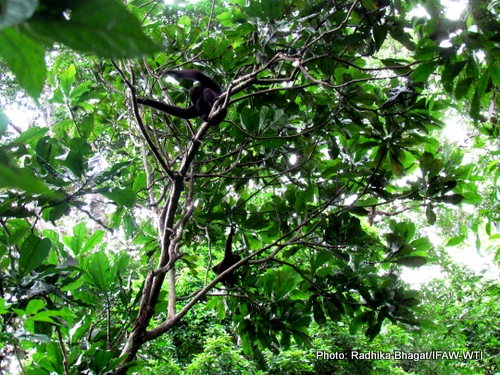IFAW-WTI Rescues and Translocates Stranded Gibbon Family in Arunachal
Wakro, November 4, 2015: Wildlife Trust of India (WTI) and International Fund for Animal Welfare (IFAW) rescued a family of gibbons from a discontinuous canopy cover in Wakro in Arunachal Pradesh and translocated them to a dense reserve forest contiguous to Kamlang Wildlife Sanctuary in the state on November 4, 2015. The family consisted of an adult male, an adult female and a sub-adult female.
Moreover, at least six more families stranded in discontinuous canopy in the area are expected to be translocated in the coming months. A more detailed assessment is being conducted to assess threats to other resident gibbons in the area. Till date, IFAW-WTI and the Arunachal Pradesh Forest Department have captured and translocated nine families of stranded gibbons from Dello village to a viable habitat in Mehao Wildlife Sanctuary in Arunachal Pradesh.
Earlier this year, two local wildlife enthusiasts, Jeevin Minin and Sofreng Hakung, informed IFAW-WTI about the presence of a gibbon family in an agricultural field with few trees and a broken canopy in Wakro. According to them, these animals needed to be immediately shifted for their well-being. IFAW-WTI immediately responded to the crisis and post assessment decided to shift the animals to the alternate site with continuous canopy cover after assessing the situation identified through a detailed site selection study.
The family was under constant threat from humans and dogs considering the little tree cover in the area. “Considering the tree cover in the area, the habitat would not have supported this family for much longer,” said Sunil Kyrong, Regional Head, Arunachal Pradesh, IFAW-WTI.
Meanwhile, JeevinMinin and Sofreng Hakung were constantly monitoring these animals before capture to confirm their location and safety. On the basis of their feedback and assessment by IFAW-WTI team, it was decided that the animals would be captured on November 3 and released the next day.
The IFAW-WTI team reached the site on November 1 which was followed by a meeting where the plan of action was formulated for the next three days. During the course of the meeting, each member was assigned tasks that they would be responsible for.
The team consisted of Koj, DFO, Kamlang Wildlife Sanctuary, IFAW-WTI staff and local team members. “On November 2,the team reached the site early morning for a recce and found the family to be in an ideal location for capture. The local team helped prepare the capture site and also placed white plastic sheets using bamboos all around the capture site. This has been tested in previous captures and acts as a psychological barrier for the gibbons, preventing their escape once they are on ground,” said Radhika Bhagat, Head, Wild Aid.
The team then commenced preparations for capture. Once the site was ready, some team members camped there at night to ensure the gibbons do not escape in the cover of the dark.
On November 3, the entire team reached the spot at sunrise with all equipments andnecessary veterinary aid. Sunil and Iphra lead the capture in the presence of the DFO. The sub-adult female was the first to be captured as she jumped on to a bamboo thicket making it easier for the team. Capturing the adult female and male was a bigger challenge in comparison to that of the sub-adult. “Despite all the hardships, the team managed to capture the other two as well. Immediately after the capture, the animals were sedated and underwent a health check-up by Dr Shamshul Ali. Morphometric measurements and close up pictures were taken of each animal. Even blood samples were collected for analysis,” said Sunil Kyrong.
On examination, the veterinarian suspected the adult female to be pregnant. Thereafter, the animals were moved to a secure location overnight. Based on their physical features, the team suspected that these were Western hoolock gibbons. However, the scientific approval is awaited based on samples which have been sent to the laboratory. If confirmed, this will be a new finding as this is not within the known distribution range of Western hoolock gibbons.
The next morning, the team started very early to reach the release site which was based on a site selection study conducted by the IFAW-WTI team. On reaching the site, the team was overwhelmed with the sheer beauty of this natural paradise and deliberated on what should be the ideal location to release the gibbons. Soon after, the team started the monitoring phase which will last for next three months.













